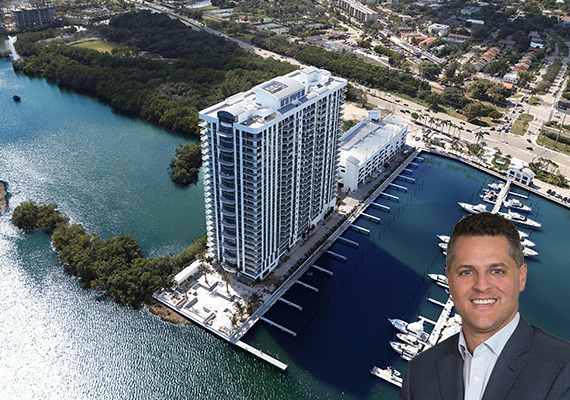Marina Palms in North Miami Beach is piling on incentives to sell its remaining units, marking the latest project to try to capture buyers’ attention amid a sluggish market, The Real Deal has learned.
The twin-tower condominium project is offering a year free of taxes and homeowners’ association fees for those who sign contracts in April, as South Florida’s selling season wanes.
“The market has slowed down, said Michael Internoscia, managing broker of Marina Palms Realty, “and incentives drive brokers and drive clients to make decisions.”
An agent with Marina Palms‘ in-house brokerage just sent out an email blast touting the incentives at The Reserve at Marina Palms, the project’s second tower.
Internoscia said the project’s first 234-unit tower is sold out and its second tower, The Reserve, has 26 units remaining of 234, including 13 penthouses. Prices range from $990,000 for a two-bedroom, two-bath unit with 1,560 square feet to $4 million for penthouses spanning 3,700 square feet, with four bedrooms and four-and-a-half bathrooms.
At an average price of $1.3 million and 2,000 square feet, and maintenance at $.50 a square foot, he estimates the maintenance savings would amount to $1,000 a month or $12,000 for the year. A year of taxes is estimated to average $10,000, based on current developer tax records. That’s a total of about $22,000 in incentives, on average.
The Plaza Group and DevStar Group are the developers behind Marina Palms’s two 25-story tower project on 172nd Street and Biscayne Boulevard in North Miami Beach.
Closings for The Reserve began in late February, with about 160 units closed so far, and construction financing has now been repaid, Internoscia said. Buyers have hailed mostly from Brazil, Mexico, Canada and the Northeast and California, with just one sale to a local family.
“When you get to the end of your project, you’re looking to finish,” Internoscia said. The developers are looking into other condo projects in Fort Lauderdale and Miami, he added, but declined to elaborate.
The condo market in South Florida has slowed significantly in the past year, as foreign buyers face economic and currency woes. Internoscia acknowledged that the market has changed and said the selling season lasts just through the end of April.
“We like to do our last big hit in April, then cruise through the summertime and then be done by the end of this year,” he said.
The 14.5-acre Marina Palms project includes a marina with 112 slips, a sundry store, boat and jet ski rentals. Each tower has an infinity pool, sauna and steam room and gym, and Internoscia said the second tower has added amenities, including a yoga deck and Brazilian rodizio grilling station. A Rolls-Royce Ghost is also available to ferry residents within a five-mile radius. Palms was built by Coastal Construction and Steven G handled interior design.
Marina Palms is the first major project to be completed in North Miami Beach this cycle, and the first one in Miami-Dade with a new full-service marina in two decades, the developers have said.
Other South Florida developers are also increasingly turning to incentives to unload units. Last week, the Related Group unleashed a slew of incentives for its Paraiso condo towers in Miami’s Edgewater neighborhood. Fortune International Group, which handles sales for the project, sent out an email boasting free maintenance for a year on new contracts signed by March 31, and offered 30 percent deposits, rather than the usual 50 percent, which has been the standard among new condo developments this cycle. Commissions at Paraiso were already raised to 8 percent to 10 percent, depending on the tower, far above the original 5 percent.
Peter Zalewski, principal of Cranespotters, said incentives are becoming more common in slow market. “A developer does not want to cut pricing, so what a developer will do first is raise commissions for brokers; second, eliminate or offer free maintenance; third is provide an incentive or credit for buildout of units; and the final step is reduce prices,” Zalewski said last week. “So we are about halfway through the process when you have too many units and not enough buyers.
